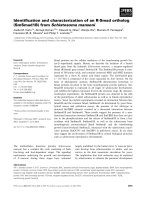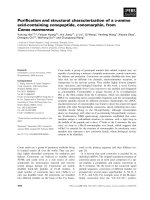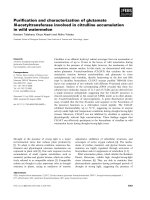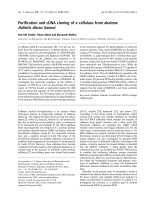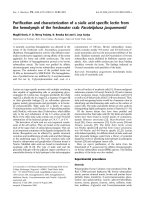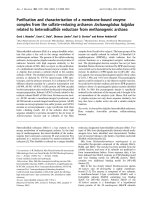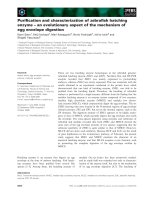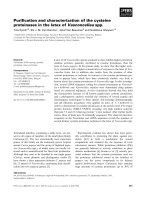Báo cáo khoa học: Purification and characterization of the cysteine proteinases in the latex of Vasconcellea spp. ppt
Bạn đang xem bản rút gọn của tài liệu. Xem và tải ngay bản đầy đủ của tài liệu tại đây (2.48 MB, 12 trang )
Purification and characterization of the cysteine
proteinases in the latex of Vasconcellea spp.
Tina Kyndt
1,2
, Els J. M. Van Damme
1
, Jozef Van Beeumen
3
and Godelieve Gheysen
1,2
1 Department of Molecular Biotechnology, Faculty of Bioscience Engineering, Ghent University, Belgium
2 Institute for Plant Biotechnology for Developing Countries (IPBO), Ghent University, Belgium
3 Laboratory of Protein Biochemistry and Protein Engineering, Ghent, Belgium
Articulated laticifers, containing a milky latex, are pre-
sent in all organs of members of the small plant family
Caricaceae [1]. The two economically most important
genera of this family are the commonly grown tropical
species Carica papaya and the group of highland papa-
yas (Vasconcellea spp.), of which many are locally tol-
erated and ⁄ or semicultivated for their fruit production.
Although they used to be classified in one single genus
(Carica), recent phenetic and phylogenetic results [2]
have shown a clear separation between C. papaya and
the 21 species of Vasconcellea, confirming their classifi-
cation into two separate genera [3].
Experimental evidence has shown that latex gener-
ally contributes to protecting the plant against pre-
dators [4,5] in both a mechanical (by wound
coagulation) and chemical (by the presence of toxic
substances) manner. While proteinase inhibitors (PIs)
are generally believed to actively contribute to plant
defence mechanisms [6], Konno et al. [5] recently pro-
vided evidence that the cysteine proteinases (and not
the proteinase inhibitors) stored in the laticifers of
papaya are the active compounds in its defence
against herbivorous insects. Caricaceae latex contains
huge amounts of cysteine proteinases: up to 30% of
Keywords
Caricaceae; cDNA cloning; cysteine
proteinase; latex; purification
Correspondence
G. Gheysen, Department of Molecular
Biotechnology, Ghent University, Coupure
Links 653, 9000 Ghent, Belgium
Fax: +32 92646219
Tel: +32 92645888
E-mail:
(Received 24 July 2006, revised 19 October
2006, accepted 13 November 2006)
doi:10.1111/j.1742-4658.2006.05592.x
Latex of all Vasconcellea species analyzed to date exhibits higher proteolytic
amidase activities, generally attributed to cysteine proteinases, than the
latex of Carica papaya. In the present study, we show that this higher activ-
ity is correlated with a higher concentration of enzymes in the latex of Vas-
concellea fruits, but in addition also results from the presence of other
cysteine proteinases or isoforms. In contrast to the cysteine proteinases pre-
sent in papaya latex, which have been extensively studied, very little is
known about the cysteine proteinases of Vasconcellea spp. In this investiga-
tion, several cDNA sequences coding for cysteine proteinases in Vasconcel-
lea · heilbornii and Vasconcellea stipulata were determined using primers
based on conserved sequences. In silico translation showed that they hold
the characteristic features of all known papain-class cysteine proteinases,
and a phylogenetic analysis revealed the existence of several papain and
chymopapain homologues in these species. Ion-exchange chromatography
and gel filtration procedures were applied on latex of V. · heilbornii in
order to characterize its cysteine proteinases at the protein level. Five major
protein fractions (VXH-I–VXH-V) revealing very high amidase activities
(between 7.5 and 23.3 nkatÆmg protein
)1
) were isolated. After further purifi-
cation, three of them were N-terminally sequenced. The observed microhet-
erogeneity in the N-terminal and cDNA sequences reveals the presence of
several distinct cysteine proteinase isoforms in the latex of Vasconcellea spp.
Abbreviations
AA, amino acid; BAPNA, a-N-benzoyl-
L-arginine 4-nitroanilide; MP, maximum parsimony; PI, proteinase inhibitor; VXH,
Vasconcellea · heilbornii.
FEBS Journal 274 (2007) 451–462 ª 2006 The Authors Journal compilation ª 2006 FEBS 451
the total latex [3], at a molar concentration that
probably exceeds 1 mm [7]. Cysteine proteinases are
proteolytic enzymes that depend upon a cysteine resi-
due for activity. Within this group of enzymes, at
least seven different evolutionary origins have been
determined, allocating them to seven clans, each con-
sisting of several related families [8].
Because of their economic importance in the bever-
age, food and pharmaceutical industries, constituents
of the latex of C. papaya have been investigated thor-
oughly. The four cysteine proteinases present in the
latex of C. papaya, namely papain (EC 3.4.22.2),
chymopapain (EC 3.4.22.6), caricain (formerly known
as proteinase W; EC 3.4.22.30) and glycyl endopepti-
dase (or papaya proteinase IV; EC 3.4.22.25), all
belong to the C1 family of clan CA, the largest clan of
cysteine peptidases. Although papain is a minor con-
stituent among the papaya proteinases, this latex
enzyme has been most extensively studied in the past
[9,10]. Amino acid sequences of papaya cysteine pro-
teinases have been determined both at the protein level
[9,11,12] and through sequencing of the corresponding
cDNA clones [13–16]. Two similar but distinct cDNAs
have been shown to code for caricain [14] and at least
five similar but distinct cDNAs code for chymopapain
[16]. In the genus Vasconcellea, only the latex of Vas-
concellea cundinamarcensis has been studied in detail
until now. These studies [17–20] suggested the existence
of six to seven cysteine proteinases in latex from
V. cundinamarcensis, some of which may be isoforms.
Five of them were sequenced at the amino acid and ⁄ or
nucleotide level. It has been reported [21] that the
activity of freeze-dried latex from this species was
between five- and eight-fold higher than that of
C. papaya latex, while crude babaco (Vasconcellea ·
heilbornii ‘babaco’) latex revealed an equivalent or
slightly higher proteolytic and lipolytic activity than
that of papaya [22]. In a larger study, comparing the
proteolytic activity of C. papaya latex with that from
Vasconcellea stipulata, some V. · heilbornii genotypes,
babaco, and V. cundinamarcensis [23], a four- to 13-
fold higher proteolytic activity was reported for these
Vasconcellea spp. Even though the different studies are
not consistent about the level of proteolytic activity,
probably due to varying experimental conditions, they
confirm the potential of Vasconcellea spp. for commer-
cial proteinase production.
In this study, we report on the identification and
characterization of cDNA sequences coding for cys-
teine proteinases in the latex of V. stipulata and
V. · heilbornii. Based on these sequences, the evolution
of the cysteine proteinases within the Caricaceae was
investigated. Furthermore, proteolytic enzymes were
purified from the latex of V. · heilbornii and the N-ter-
minal amino acid sequence characterized.
Results and Discussion
Amidase activity of total latex
Proteolytic activity, measured as amidase activity per
milligram dried latex using the BAPNA (a-N-benzoyl-
l-arginine 4-nitroanilide) substrate, was evaluated by
Scheldeman et al . [23] for several Vasconcellea spe-
cies. They reported that Vasconcellea cundinamarcensis,
V. stipulata and V. · heilbornii latex show a proteolytic
activity that is approximately 4–13 times higher than
the papaya reference. Two factors might play a role in
the higher activity observed in Vasconcellea spp.: (1) a
higher protein content in their latex; and (2) the pres-
ence of other cysteine proteinases or isoforms in the
latex. To investigate these two hypotheses, the protein
concentration per milligram of dried latex, as well as
the amidase activity per milligram of protein, was
measured for three species (Table 1). The results show
that the protein concentration in Vasconcellea latex is
indeed slightly higher than in the papaya reference.
Proteolytic activity, measured by BAPNA degradation
and expressed as amounts of nkat per milligram pro-
tein (where nkat is amount of enzyme that hydrolyses
1 nmol BAPNA per second), is found to be 1.25 to
two times higher in latex of Vasconcellea fruits than in
latex of C. papaya. Hence, when analyzing equal
amounts of protein, the latex of Vasconcellea fruits
still displays a stronger proteolytic effect, although the
differences are not as pronounced as reported by
Scheldeman et al. [23]. However, our results are
obtained with latex from one single plant of each spe-
cies, grown under suboptimal, but consistent, green-
house conditions, while Scheldeman et al. [23]
investigated several (2–8) wild plants of each species. It
is possible that wild plants reveal a higher proteolytic
activity or protein content than greenhouse plants. In
addition, it has been demonstrated that repeated
mechanical wounding of the fruit profoundly affects
Table 1. Protein concentration and amidase activity of latex of
Vasconcellea and C. papaya fruits.
Species
Protein
concentration
(mgÆg latex
)1
)
Proteolytic activity
(nkatÆmg protein
)1
)
Proteolytic activity
(nkatÆmg latex
)1
)
C. papaya 26.69 6.50 0.17
V. monoica 36.31 8.09 0.29
V. stipulata 40.57 12.98 0.53
V. · heilbornii 31.75 8.65 0.27
Cysteine proteinases of Vasconcellea spp. T. Kyndt et al.
452 FEBS Journal 274 (2007) 451–462 ª 2006 The Authors Journal compilation ª 2006 FEBS
the protein content and activation of proteolytic
enzymes in its latex [24]. While the fruits used in this
experiment were all tapped for the first time, we are
not aware of the frequency of tapping in other studies.
These and probably several other, as yet unknown,
factors affecting the activity and concentration of latex
proteins complicate comparisons with previous studies.
Our results (Table 1), obtained using equal condi-
tions for all plants, clearly show that the higher pro-
teolytic activity is only to a certain extent due to a
higher protein concentration in latex of Vasconcellea
fruit. The presence of other, possibly more proteolyti-
cally active enzymes will be evaluated in the following
experiments.
cDNAs coding for cysteine proteinases in
V.
·
heilbornii and V. stipulata
Using a PCR approach with a cysteine proteinase
primer (CyPr), specifically designed for this study,
different cDNAs were isolated from the fruits of
V. · heilbornii: VXH-A, VXH-B, VXH-C, VXH-D,
and from that of V. stipulata: VS-A and VS-B. The
amino acid sequence of all six cDNA-sequences was
deduced in silico and analyzed. A detailed comparison
was made with the available sequence data for cysteine
proteinases from Caricaceae found in the GenBank
database (Fig. 1). These sequences included complete
cDNAs from papain, glycyl endopeptidase, two iso-
forms of caricain and five isoforms of chymopapain
from C. papaya. From the genus Vasconcellea, only
the latex of V. cundinamarcensis has previously been
studied in detail. Isolation and preliminary characteri-
zation of the cysteine proteinases using ion-exchange
chromatography showed four enzymatically active
peaks in its latex, designated CC-I to CC-IV [17].
CC-III was almost completely sequenced [19] and has
been suggested to correspond to chymopapain from
papaya [17]. Further purification of the heterogeneous
CC-I [18] into the two closely related components
CC-Ia and CC-Ib was carried out using reverse-phase
HPLC under denaturing conditions. Amino acid
sequencing of both CC-Ia and CC-Ib confirmed their
equivalence with papain. Based on the observation that
CC-I and papain have catalytic constants of the same
order of magnitude on BAPNA and chromozyme [17],
the marked increase in proteolytic activity of V. cundi-
namarcensis latex can be explained by the expression
of several molecular forms of CC-I, in contrast to the
single papain in papaya [18]. Another cysteine protein-
ase, CC-23, was purified from V. cundinamarcensis
latex and its corresponding DNA fragment cloned by
Pereira et al. [20]. The N-terminal sequence appeared
to be different from the N-terminal sequences reported
for CC-I to CC-IV. The authors suggested the existence
of six to seven cysteine proteinases in latex from V. cun-
dinamarcensis, some of which may be isoforms, as in the
case of chymopapain. For V. cundinamarcensis, one
incomplete DNA-sequence (no stop codon) called
CC-23, and five amino acid sequences were traced in the
database: CC-Ia, CC-Ib, CC-II, CC-III, CC-IV. CC-II
and CC-IV were only N-terminally sequenced [17].
Although CC-Ia (213 amino acids), CC-Ib (213 amino
acids) and CC-III (214 amino acids) have a calculated
mass corresponding to mass spectrometric results
[18,19], they might be incomplete at the 3¢ end.
Papaya proteinases are naturally synthesized with
N-terminal signal and pro-peptides. The pro-regions
aid the folding of the mature enzymes and act as
selective high affinity inhibitors to prevent inappropri-
ate proteolysis within the plant [25]. The enzymes are
present in the latex as inactive precursors and are
activated in response to wounding of the plant [26].
Similar to other known cysteine proteinases from Car-
icaceae, the deduced protein sequences of VXH-A, -B,
-C and -D, and VS-A and -B, were predicted to con-
tain a signal peptide. For most of them, this signal
peptide contains 26 amino acids. However, the signal
peptide prediction software SignalP predicts VXH-B to
be cleaved after 22 residues. The proregion of the pri-
mary translation products contains 108 amino acids
(or 112 amino acids in the case of VXH-B). Only for
VS-A, a stop codon was found in the cDNA-sequence
obtained. This cDNA encodes a mature protein of 188
amino acids with a calculated molecular weight of
20.3 kDa. As no stop codon was found in the other
sequences, it is very likely that these sequences are not
complete at the 3¢ end.
The characteristic features of all known papain class
cysteine proteinases are present in the amino acid
sequences from V. stipulata and V. · heilbornii: the cat-
alytic triad C
25
,H
159
,N
175
, stabilizer Q
19
,D
158
(yellow
stars in Fig. 1), six cysteines forming three disulfide
bridges (blue stars in Fig. 1), as well as the well-con-
served
173
IKNSWG
178
motif (numbering of amino
acids according to their position in mature papain).
One putative N-glycosylation site occurs in the prore-
gion of VS-A and VXH-A:
115
NWS
117
. The glycan in
the propeptide might aid in the protection against deg-
radation, or in targeting or maturation of the enzyme,
as was shown before in cathepsin C, which also belongs
to the papain family of cysteine proteinases [27].
The overall similarity at the amino acid level
between all known cysteine proteinases from Carica-
ceae is 73%. Tables 2 and 3 show the percentage
sequence similarity between the obtained cDNA
T. Kyndt et al. Cysteine proteinases of Vasconcellea spp.
FEBS Journal 274 (2007) 451–462 ª 2006 The Authors Journal compilation ª 2006 FEBS 453
Fig. 1. Alignment of translated cDNAs of V. stipulata (VS), V. · heilbornii (VXH), V. cundinamarcensis (CC) and C. papaya. The transition
between signal peptide and proregion is indicated by a red arrow. The black arrow shows the beginning of the mature enzyme. Cysteine res-
idues involved in disulfide bridges are indicated with blue stars. Yellow stars show amino acids which are important for proteolytic activity.
Cysteine proteinases of Vasconcellea spp. T. Kyndt et al.
454 FEBS Journal 274 (2007) 451–462 ª 2006 The Authors Journal compilation ª 2006 FEBS
sequences and all known cysteine proteinases from the
Caricaceae. VXH-A and VS-A are almost identical
(99%) at the amino acid and nucleotide level. A single
amino acid substitution is present at position 122 of
VXH-A, where a serine is replaced by a proline in
VS-A. As is the case for CC-Ia, CC-Ib [18], CC23 [20],
CCIII [19], and papain [11], VS-A, VS-B and VXH-A
lack the insertion of four amino acids between position
168 and 169, which is present in all other cysteine
proteinases of plant or animal origin. Unfortunately,
Table 2. Percentage sequence similarity between the cDNA sequences of V. stipulata and V. · heilbornii, and known cysteine proteinases
from Caricaceae. Values >85% are indicated in bold. Chymo, Chymopapain; Gly endo, glycyl endopeptidase.
CC-Ia CC-Ib CC-II CC-III CC-IV CC23 Chymo ChymoII ChymoIII ChymoIV ChymoV Papain Caricain CaricainII Gly endo
VS-A 90.4 95.2 76.7 63.4 76.7 65.3 61.5 61.5 61.2 61.5 60.1 69.2 70.6 70.9 68.1
VS-B 61.5 63.9 93.0 82.1 86.0 88.6 71.4 71.1 70.8 72.6 70.8 60.8 66.6 66.9 66.6
VXH-A 91.6 96.1 76.7 63.5 76.7 65.1 61.2 61.2 60.9 61.2 59.8 69.8 71.3 71.6 68.1
VXH-B 93.1 87.8 76.7 61.4 74.4 65.4 61.7 61.3 60.9 62.6 59.8 68.3 70.5 70.8 67.4
VXH-C 59.9 61.2 97.7 75.7 81.4 82.2 67.7 67.4 67.0 64.6 62.8 61.2 63.6 63.9 62.5
VXH-D 89.4 100.0 76.7 61.3 74.4 64.3 61.6 61.6 61.2 61.7 59.9 67.3 69.0 69.3 66.1
Fig. 1. (Continued).
T. Kyndt et al. Cysteine proteinases of Vasconcellea spp.
FEBS Journal 274 (2007) 451–462 ª 2006 The Authors Journal compilation ª 2006 FEBS 455
this part of the sequence is not available for CC-II and
CC-IV from V. cundinamarcensis and VXH-B, C and
D. However, based on the close evolutionary relation-
ships between Vasconcellea spp. [2]., we assume that
other cysteine proteinases from this genus will also
have this deletion.
Molecular evolution of cysteine proteinases
in Caricaceae
The evolutionary relationships between the amino acid
sequences are represented by the 50% Majority Rule
Consensus tree of 3 Maximum Parsimonious (MP)
trees shown in Fig. 2. The relatively high bootstrap
values express a high degree of confidence in the gener-
ated clustering. Glycyl endopeptidase was chosen as
the outgroup because of its low degree of similarity
with the other sequences. The MP tree reveals three
major clusters. Cluster I combines the five chymo-
papain isoforms of C. papaya with VXH-C, VS-B,
CC-III and CC23. These results confirm the hypothesis
of Walraevens et al. [17] that CC-III is a chymopapain
homologue and predict VXH-C and VS-B to be the
corresponding genes in V. · heilbornii and V. stipulata,
respectively. In addition, this suggests CC23 to be a
Table 3. Percentage pairwise sequence similarity between the cys-
teine proteinase cDNA sequences of V. stipulata and V. · heilbornii.
Values higher than 85% are indicated in bold.
VS-A VS-B VXH-A VXH-B VXH-C VXH-D
VS-A 100.0
VS-B 66.1 100.0
VXH-A 99.7 67.3 100.0
VXH-B 91.0 64.7 91.3 100.0
VXH-C 63.8 86.5 64.4 63.0 100.0
VXH-D 95.7 65.9 96.0 91.4 63.0 100.0
Fig. 2. The 50% Majority Rule Consensus
tree of three Maximum parsimonious trees
of cysteine proteinases of V. stipulata (VS),
V. · heilbornii (VXH), V. cundinamarcensis
(CC) and C. papaya. (Tree length ¼ 498,
consistency index ¼ 0.8193, retention
index ¼ 0.8811). Bootstrap values are indi-
cated above the branches.
Cysteine proteinases of Vasconcellea spp. T. Kyndt et al.
456 FEBS Journal 274 (2007) 451–462 ª 2006 The Authors Journal compilation ª 2006 FEBS
paralogue of CC-III, possibly also coding for a chymo-
papain-like enzyme.
Cluster II contains papain, next to VXH-A, VXH-B,
VXH-D, VS-A, CC-Ia and CC-Ib, suggesting them to
be papain homologues. Earlier observations [17,18]
already suggested CC-I (containing CC-Ia and CC-Ib)
to be the heterogenic papain homologue of V. cundina-
marcensis. This heterogeneity was suggested to be
responsible for the higher enzymatic activity found in
latex of V. cundinamarcensis [18]. Our study reveals
three predicted papain homologues in the highly enzy-
matically active V. · heilbornii latex, but only one in
V. stipulata. However, it is possible that further
searches will reveal more than one papain homologue
in the latex of V. stipulata.
Although the different parologues and orthologues
make the picture rather complex, the close phylo-
genetic relationship between the cysteine proteinase
sequences from V. cundinamarcensis and the newly
determined sequence data from V. · heilbornii and
V. stipulata, again confirm the evolutionary divergence
between C. papaya and the Vasconcellea spp. [2].
From the proposed evolutionary relationships of cys-
teine proteinases it can be deduced that the common
ancestor of the genera Carica and Vasconcellea
already contained at least two different cysteine pro-
teinases in its latex (papain and chymopapain). After
the divergence of these genera, their genes have
evolved into different paralogues. Within the genus
Vasconcellea, the evolutionary pathway of cysteine
proteinases are probably obscured by different factors:
(1) the close relationship between the three analyzed
species, with V. stipulata and V. cundinamarcensis
being involved in the hybrid origin of V. · heilbornii
[28], and (2) their reported recent speciation [2]. Since
no caricain or glycyl endopeptidase homologues have
yet been found in V. cundinamarcensis, V. stipulata
and V. · heilbornii, it is not possible to draw conclu-
sions about their evolution.
Fractionation of the proteinases
from V.
·
heilbornii
In an attempt to purify the proteinases from V. · heil-
bornii, latex was collected and subjected to ion
exchange chromatography. Figure 3 displays a typical
elution profile from the Mono S 5 ⁄ 50 GL column of
the total dialysed soluble fraction of the latex of
V. · heilbornii. In general, five peaks with apparent
microheterogeneity can be distinguished: VXH-I,
VXH-II, VXH-III, VXH-IV and VXH-V, all showing
amidase activity (Table 4). Amidase activity was inhib-
ited by the addition of the cysteine proteinase inhibitor
E-64. This observation clearly showed that the proteo-
lytic activity was due to cysteine proteinases solely.
Specific amidase activity of VXH-I toVXH-V ranged
from 7.5 to 23.3 nkatÆmg protein
)1
, which is 4.5- to
14-fold higher than the activity of chymopapain from
papaya latex (1.68 nkatÆmg
)1
) [28]. The activities
observed are comparable with the 14.2 nkat ⁄ mg found
for CC28 (or CC-IV) from V. cundinamarcensis [29],
but significantly lower than the activity of CC23, also
found in the latex of this species, which was reported
to be 84 nkatÆmg
)1
[20].
SDS ⁄ PAGE analysis of the protein fractions
obtained after ion exchange chromatography revealed
the presence of smaller, contaminating polypeptides
next to proteins of expected molecular size for cysteine
proteinases (results not shown). Therefore, additional
chromatographic steps had to be performed to remove
these small polypeptides.
Unfortunately, Vasconcellea plants growing in a
greenhouse produce small fruits that contain only low
amounts of latex. In addition, as they do not bear
L
Fig. 3. Ion exchange chromatography of
V. · heilbornii latex on Mono S 5 ⁄ 50 GL
column. Buffer: 50 m
M NaAc, pH 5.0; flow
rate: 2 mLÆmin
)1
; gradient: 0–1 M NaCl,
pH 5.0. The triangles show absorbance
(A
280
) of each fraction. The black line repre-
sents the conductivity.
T. Kyndt et al. Cysteine proteinases of Vasconcellea spp.
FEBS Journal 274 (2007) 451–462 ª 2006 The Authors Journal compilation ª 2006 FEBS 457
fruits all year round, our purification was hampered
by the limited amount of starting material available.
Therefore, fractions VXH-I–VXH-V from the first ion
exchange chromatography were pooled, and rechroma-
tographed on a gel filtration column in an attempt to
remove the smaller proteins. Size-exclusion chromato-
graphy yielded essentially one large peak (data not
shown) which was divided into pools A and B.
Whereas the later fractions (pool B) revealed two pro-
tein bands of 27 and 30 kDa after SDS ⁄ PAGE, the
earlier fractions (pool A) showed an extra protein
band of higher molecular weight (33 kDa) (Fig. 4).
SDS ⁄ PAGE results confirm that the smaller contamin-
ating proteins have been removed after gel filtration.
The size of the polypeptides present in pools A and B
is equivalent to or slightly larger than the molecular
mass reported for papain (23 kDa), chymopapain
(27 kDa) [30], caricain (24 kDa) [11], CC-IV (28 kDa)
[29] and CC23 (23 kDa) [20]. Subsequently, the pro-
teins in pools A and B were re-fractionated using ion-
exchange chromatography (Fig. 5A,B). Pool A yielded
three major peaks. Comparison of the elution profiles
in Figs 3 and 5A,B suggests that these peaks corres-
pond to VXH-I, VXH-III and the second part of
VXH-IV (VXH-VIb). Pool B contained only two
peaks (Fig. 5B), corresponding to VXH-III and the
earlier part of VXH-IV (VXH-IVa). Apparently peaks
VXH-II and VXH-V are not present in pools A and B
after the gel filtration analysis. Four of these recovered
peaks were selected for N-terminal protein sequence
analysis: VXH-I and VXH-IVb from pool A, VXH-III
and VXH-IVa from pool B.
The microheterogeneity observed during all purifica-
tion steps, indicating that there are multiple isoforms
of the proteolytic enzymes in the latex of V. · heilbor-
nii, was previously also reported for C. papaya [3] and
V. cundinamarcensis [18].
Comparison of N-terminal sequences of
V.
·
heilbornii cysteine proteinases
The N-terminal amino acid sequences of the proteins
VXH-I, VXH-III, VXH-IVa and VXH-IVb are shown
in Fig. 6, and are compared with the known
N-terminal sequences of the cysteine proteinases of
C. papaya and V. cundinamarcensis. The cysteine pro-
teinases of V. · heilbornii hold the generally conserved
P
2
,Q
19
and the
11
GAVTP
15
-motif located at the N-ter-
minus of papain-like cysteine proteinases, leaving no
doubt that these proteins belong to the papain super-
family. Sequencing of VXH-I and VXH-III yielded
two signals of equal intensity at positions 7 and 17,
respectively, suggesting that these pools might contain
different isoforms. The N-terminal sequences of VXH-
IVa and VXH-IVb reveal different amino acids at
positions 9, 18 and 20, confirming that peak VXH-IV
holds at least two different cysteine proteinases.
All N-terminal sequences show between 65 and
100% similarity, with an average of 80%. Such a high
degree of homology makes it difficult to decide which
form of VXH corresponds to which papaya or V. cun-
dinamarcensis proteinase. The identical N-terminal
sequence of VXH-IVb, CC-III and CC-IV suggests
that these might be homologous proteins, but complete
sequencing is necessary to confirm this result. Based
on the 100% identity between the deduced amino acid
sequence of VXH-C and the N-terminal sequence of
VXH-I (Fig. 1) we can assume that cDNA clone
VXH-C encodes VXH-I.
Table 4. Amidase activity of pooled fractions VXH-I–VXH-V, meas-
ured by BAPNA degradation. nkat: amount of enzyme that hydro-
lyses 1 nmol BAPNA per second.
Pool nkatÆmg protein
)1
VXH-I 23.3
VXH-II 12.5
VXH-III 22.1
VXH-IV 15.0
VXH-V 7.5
Fig. 4. SDS ⁄ PAGE electrophoresis of pool A and pool B from the
latex of V. · heilbornii. M: Protein molecular weight marker; mas-
ses are indicated on the left.
Cysteine proteinases of Vasconcellea spp. T. Kyndt et al.
458 FEBS Journal 274 (2007) 451–462 ª 2006 The Authors Journal compilation ª 2006 FEBS
Conclusion
This study confirms a higher degree of proteolytic
activity in the latex of three Vasconcellea spp. in com-
parison with C. papaya. This is due to a higher protein
content and the presence of other, more active, cys-
teine proteinases in their latex. Fractionation of
V. · heilbornii latex revealed that this species contains
several highly proteolytic cysteine proteinases. Further-
more, sequence analyzes at the amino acid and cDNA
level showed a high degree of homology between cys-
teine proteinases from different species of Caricaceae.
The large number of different cDNA-sequences, and
the observed microheterogeneity during the purifica-
tion procedure, imply that V. stipulata and V. · heil-
bornii express several isoforms of cysteine proteinases
in their latex, which may be responsible for the higher
proteolytic activity.
The amount of latex that can be collected from the
(generally smaller) fruits of the wild Vasconcellea
plants is definitely lower than the latex yield of
papaya (personal observations). Consequently, future
Vasconcellea breeding programmes should select for
varieties with a higher latex yield, to obtain a commer-
cially interesting latex production.
Experimental procedures
Latex collection
Unripe fruits of plants grown in the greenhouse were the
source of latex used in this study. Latex was collected by
making several incisions into the surface of the unripe fruit
using a sharp blade. An equal volume of 100 mm thio-
ureum was added to avoid oxidation, as recommended by
Azarkan et al. [31], and the latex was stored at )20 °Cin
the dark, until use.
Electrophoresis
Protein samples were electrophoresed in 15% polyacryl-
amide denaturing gels (SDS ⁄ PAGE) [32] after boiling for
5 min at 95 °C. Electrophoresis was performed for 90 min
at 150 V. Gels were stained with 0.1% Coomassie blue
A
B
L
L
Fig. 5. Second ion exchange chromatography
after size-selection of pool B from the latex of
V. · heilbornii. Columns: mono S 5 ⁄ 50 GL;
buffer: 50 m
M sodium acetate, pH 5.0; flow
rate: 2 mLÆmin
)1
; gradient: 0–1 M NaCl,
pH 5.0. The triangles show absorbance (A
280
)
of each fraction. The black line indicates the
conductivity. (A) Fractionation of pool A;
(B) fractionation of pool B.
T. Kyndt et al. Cysteine proteinases of Vasconcellea spp.
FEBS Journal 274 (2007) 451–462 ª 2006 The Authors Journal compilation ª 2006 FEBS 459
R-250 dissolved in 42% methanol)17% acetic acid fol-
lowed by destaining in 15% ethanol)7.5% acetic acid.
Amidase activity
For analysis of amidase activity, 80 lL of the sample was
preincubated for 10 min at 37 °C in 100 lL activation buf-
fer, containing 2.5 mm dithiothreitol, 25 mml-cysteine,
5mm EDTA, 100 mm sodium phosphate, 100 mm sodium
citrate and 100 mm borate in 25 mm Tris ⁄ HCl, pH 7. The
enzymatic hydrolysis of l-BAPNA substrate (Sigma-
Aldrich, Steinheim, Germany) was measured following
incubation with 20 lL10mm BAPNA (in 1% dimethyl
sulfoxide) for 20–60 min at 37 °C. The reaction was stopped
by adding 20 lL 50% acetic acid, and the release of 4-nitro-
aniline was determined spectrophotometrically at 410 nm
(e
410
¼ 8800 mol
)1
Æcm
)1
). The hydrolysis time was adjusted
in order to avoid A
410
exceeding 0.80. One unit of activity
(nkat) is the amount of enzyme that hydrolyses 1 nmol of
substrate per second under the above-cited conditions.
Cloning and sequencing of cysteine proteinase
cDNAs
RNA was extracted using the Qiagen Rneasy Plant Mini
Kit (Qiagen GmbH, Hilden, Germany) from unripe fruits.
The RNA was transformed into double-stranded cDNA by
LD PCR with the Creator SMART
TM
cDNA Library Con-
struction kit (BD Biosciences, Heidelberg, Germany). Dur-
ing this procedure, adapters are ligated to the 5¢ and 3¢ end
of the cDNAs. The 3¢ ends of cysteine proteinases were spe-
cifically amplified using an internal cysteine proteinase
specific primer (CyPr: 5¢-AAGGAGCYGTNACTCCT
GTAA-3¢), derived from a central conserved region present
in all known cysteine proteinases from Caricaceae, and a
primer complementary to the previously built-in 3¢ adapt-
ers. The total PCR volume of 20 lL consisted of 2 lL10·
diluted cDNA (from LD PCR), 2 lL CyPr-primer (10 lm),
2 lL3¢ adapter primer (10 lm), 2 lL Pfx amplification buf-
fer (Invitrogen, Paisley, UK), 2 lL dNTPs (5 mm), 0.4 lL
Pfx polymerase, 0.4 lL MgSO
4
(50 mm) and 9.2 lL water.
The PCR programme involved an initial denaturation for
4 min at 95 °C, followed by 30 cycles of 30 s at 95 °C, 30 s
at 55 °C and 90 s at 68 °C, and a terminal extension of
10 min at 68 °C.
PCR products were separated on 1% agarose 0.5· TAE
(20 mm Tris-Acetate, 0.5 mm EDTA) gels and purified
using the QIAquick Gel Extraction Kit (Qiagen). As the
high-fidelity Pfx polymerase was used in the PCR reaction,
terminal 3¢ A-ends had to be added to the PCR products
before they were cloned into pGEM-T plasmids (Promega
Benelux, Leiden, The Netherlands) following the manufac-
turer’s instructions. Insert sequencing was carried out in
both directions using T7 and SP6 primers. Inserts were se-
quenced using the ABI prism BigDye
TM
Terminator v1.1
Cycle Sequencing Kit (Applied Biosystems, Foster City,
CA, USA) on an automated sequencer (ABI prism 377,
Applied Biosystems). Subsequently, 5¢ ends of each 3 ¢
sequence were amplified selectively by using a sequence-
specific primer, in combination with a primer based on the
previously built-in 5¢ adapters of the double stranded
cDNA. PCR conditions and followed procedures were iden-
tical to those used during sequencing of the 3¢ end.
cDNA-sequences obtained were submitted to the Gen-
Bank database (DQ836121-DQ836126). They were trans-
lated in silico using bioedit 7.0.1 [33]. signalp and
netnglyc (Expasy Proteomics Server) were used to predict
the presence of signal peptides and possible N-glycosylation
sites, respectively.
All available cysteine proteinase amino acid sequences
from Caricaceae were aligned using bioedit 7.0.1. CC-II and
CC-IV sequences were deleted from the dataset because their
short sequences might result in incorrect phylogenetic analyz-
es. After deletion of constant characters from the alignment,
parsimony analyzes were performed with paup* v4.0b10 [34]
using the heuristic search option with random sequence addi-
tion (100 random replications) and TBR branch-swapping.
The sequence of Glycyl endopeptidase was used as an out-
group. The consistency index and retention index were calcu-
lated. Support for the different clades was tested by
bootstrap analysis (100 replicates using heuristic search,
random sequence addition and TBR branch-swapping).
Fig. 6. N-Terminal amino acid sequences of proteinases from
V. · heilbornii (VXH) and V. stipulata (VS), compared with the
known sequences from V. cundinamarcensis (CC) and C. papaya
(Cp). In the case of double signals, both amino acids are specified.
Cysteine proteinases of Vasconcellea spp. T. Kyndt et al.
460 FEBS Journal 274 (2007) 451–462 ª 2006 The Authors Journal compilation ª 2006 FEBS
Chromatographic procedures
The latex of V. · heilbornii was exhaustively dialyzed
against cold H
2
O, centrifuged for 10 min at 3000 g, and the
supernatant filtered through a Whatman paper. The filtered
solution was chromatographed on an AKTA fplc system
(Amersham Biosciences, Uppsala, Sweden) using a Mono S
5 ⁄ 50 GL column (5 · 50 mm) previously equilibrated with
50 mm sodium acetate, pH 5.0. The column was eluted
using a linear gradient of 0–1 m NaCl in 50 mm sodium
acetate (pH 5). Protein concentration and amidase activity
of all fractions was measured. SDS ⁄ PAGE of fractions with
high activity revealed the polypeptide composition. As
many of smaller contaminating polypeptides were observed,
apart from bands of the expected mass (22–30 kDa), fur-
ther purification was performed by gel filtration on a Seph-
acryl S-200 column (3 · 70 cm). The column was run in
20 mm 1,3-diamino propane, pH 11. Ion-exchange chroma-
tography of two pools (A and B) that contained protein
bands of the expected mass range was then repeated on the
Mono S 5 ⁄ 50 GL column (5 · 50 mm) under the same con-
ditions as described above.
N-Terminal protein sequencing
Following SDS ⁄ PAGE and semi-dry blotting of the selec-
ted fractions, the samples were desalted using Prosorb
Sample Preparation Cartridges (Applied Biosystems). The
N-terminal amino acid sequence of polypeptides was
determined using automated chemical Edman degradation
on a 476 A pulsed liquid sequenator equipped with an
on-line PTH-amino acid analyzer (Applied Biosystems).
Acknowledgements
Financial support for this research was provided by a
grant to T. Kyndt from the ‘Institute for the Promo-
tion of Innovation through Science and Technology in
Flanders (IWT-Vlaanderen)’ and by FWO-Vlaanderen
(project number 3G005100). We thank W. Peumans
for his extensive assistance during the protein purifi-
cation. I. Vandenberghe is acknowledged for the
N-terminal protein sequencing. The authors are also
grateful to the Department of Plant Production
(Ugent) for the greenhouse accommodation provided
for the Vasconcellea plants.
References
1 Hegnauer R (1964) Chemotaxonomie der Pflanzen, Band
3 Dicotyledonae: Acantaceae-Cyrillaceae. p. 743. Birkha
¨
-
user Report, Basel und Stuttgart.
2 Kyndt T, Van Droogenbroeck B, Romeijn-Peeters E,
Romero-Motochi JP, Scheldeman X, Goetghebeur P,
Van Damme P & Gheysen G (2005) Molecular phylo-
geny and evolution of Caricaceae based on rDNA inter-
nal transcribed spacer (ITS) and chloroplast sequence
data. Mol Phyl Evol 37, 442–459.
3 Badillo VM (2000) Carica L. vs. Vasconcella St. Hil.
(Caricaceae): con la rehabilitacio
´
n de este u´ ltimo. Erns-
tia 10, 74–79.
4 El Moussaoui A, Nijs M, Paul C, Wintjens R, Vincen-
telli J, Azarkan M & Looze Y (2001) Revisiting the
enzymes stored in the laticifers of Carica papaya in the
context of their possible participation in the plant
defence mechanism. Cell Mol Life Sci 58, 556–570.
5 Konno K, Hirayama C, Nakamura M, Tateishi K,
Tamura Y, Hattori M & Kohno K (2004) Papain pro-
tects papaya trees from herbivorous insects: role of
cysteine proteases in latex. Plant J 37, 370–378.
6 Baldwin IT & Preston CA (1999) The eco-physiological
complexity of plant responses to plant herbivores.
Planta 208, 137–245.
7 Oberg KA, Ruysschaert J, Azarkan M, Smolders N,
Zerhouni S, Wintjens R, Amrani A & Looze Y (1998)
Papaya glutamine cyclase, a plant enzyme highly resis-
tant to proteolysis, adopts an all b conformation. Eu J
Biochem 258, 214–222.
8 Barrett AJ & Rawlings ND (2001) Evolutionary lines of
cysteine peptidases. Biol Chem Hoppe-Seyler 382, 727–
733.
9 Mitchell REJ, Chaiken IM & Smith EL (1970) The
complete amino acid sequence of papain: additions and
corrections. J Biol Chem 245, 3485–3492.
10 Drenth J, Jansonius JN, Koekoek R, Swen HM &
Wolthers BG (1968) Structure of papain. Nature 218,
929–932.
11 Dubois T, Kleinschmidt T, Schnek AG, Looze Y &
Braunitzer G (1988) The thiol proteinases from the latex
of Carica papaya L. II. The primary structure of protei-
nase W. Biol Chem Hoppe-Seyler 369, 741–754.
12 Ritonja A, Buttle DJ, Rawlings N, Turk DV & Barrett
A (1989) Papaya proteinase-IV amino-acid sequence.
FEBS Lett 258, 109–112.
13 Cohen LW, Coghlan VM & Dihel LC (1986) Cloning
and sequencing of papain-encoding cDNA. Gene 48 ,
219–227.
14 Revell DF, Cummings NJ, Baker KC, Collins ME, Tay-
lor MAJ & Sumner IG (1993) Nucleotide sequence and
expression in Escherichia coli of cDNAs encoding
papaya proteinase omega from Carica papaya. Gene
127
, 221–225.
15 Baker KC, Taylor MAJ, Cummings NJ, Tunon MA,
Worboys KA & Connerton IF (1996) Autocatalytic pro-
cessing of pro-papaya proteinase IV is prevented by
crowding of the active-site cleft. Prot Eng 9, 525–529.
16 Taylor MAJ, Al-sheikh M, Revell DF, Sumner IG &
Connorton IF (1999) CDNA cloning and expression of
T. Kyndt et al. Cysteine proteinases of Vasconcellea spp.
FEBS Journal 274 (2007) 451–462 ª 2006 The Authors Journal compilation ª 2006 FEBS 461
Carica papaya prochymopapain isoforms in Escherichia
coli. Plant Sci 145, 41–47.
17 Walraevens V, Jaziri M, Van Beeumen J, Schnek AG,
Kleinschmidt T & Looze Y (1993) Isolation and charac-
terization of the cysteine-proteinases from the latex of
Carica candamarcensis Hook. Biol Chem Hoppe-Seyler
374, 501–506.
18 Walraevens V, Vandermeers-Piret M, Vandermeers A,
Gourlet P & Robberecht P (1999) Isolation and charac-
terization of the CCI papain-like cysteine proteinases
from the latex of Carica candamarcensis Hook. Biol
Chem Hoppe-Seyler 380, 485–488.
19 Jaziri M, Kleinschmidt T, Walraevens V, Schnek AG &
Looze Y (1994) Primary structure of CC-III, the glyco-
sylated cysteine proteinase from the latex of Carica
candamarcensis Hook. Biol Chem Hoppe-Seyler 375,
379–385.
20 Pereira MT, Lopes MTP, Meira WO & Salas CE (2001)
Purification of a cystein proteinase from Carica canda-
marcensis L. & cloning of a genomic putative fragment
coding for this enzyme. Prot Expr Purif 22, 249–257.
21 Baeza G, Correa D & Salas C (1990) Proteolytic
enzymes in Carica candamarcensis. J Sci Food Agric 51,
1–9.
22 Dhuique-Mayer C, Caro Y, Pina M, Ruales J, Dornier
M & Graille J (2001) Biocatalytic properties of lipase
in crude latex from Babaco fruit (Carica pentagona).
Biotechn Lett 23, 1021–1024.
23 Scheldeman X, Van Damme P & Romero-Motochi JP
(2002) Highland Papayas in Southern Ecuador: need for
conservation actions. Acta Hortic (ISHS) 575, 199–205.
24 Azarkan M, Wintjens R, Looze Y & BaeyensVolant D
(2004) Detection of three wound-induced proteins in
papaya latex. Phytochem 65, 525–534.
25 Taylor MAJ, Baker KC, Briggs GS, Connerton IF,
Cummings NJ, Pratt KA, Revell DF, Freedman RB &
Goodenough PW (1995) Recombinant pro-regions from
papain and papaya proteinase IV are selective high-affi-
nity inhibitors of the mature papaya enzymes. Prot Eng
8, 59–62.
26 Moutim V, Silva LG, Lopes MTP, Fernandes GW &
Salas CE (1999) Spontaneous processing of peptides
during coagulatio of latex from Carica papaya. Plant
Sci 142, 115–121.
27 Santilman V, Jadot M & Mainferme F (2002) Impor-
tance of the propeptide in the biosynthetic maturation
of rat cathepsin C. Eur J Cell Biol 81, 654–663.
28 Van Droogenbroeck B, Kyndt T, Romeijn-Peeters E,
Van Thuyne W, Goetghebeur P, Romero-Motochi JP &
Gheysen G (2006) Evidence of natural hybridization
and introgression between Vasconcellea species (Carica-
ceae) from southern Ecuador revealed by morphological
and chloroplast, mitochondrial and nuclear DNA mar-
kers. Ann Bot 97, 793–805.
29 Gravina de Moraes M, Termignoni C & Salas C (1994)
Biochemical characterization of a new cysteine endopep-
tidase from Carica candamarcensis L.
Plant Sci 102,
11–18.
30 Arnon R (1970) Papain. Methods Enzymol 14, 226–252.
31 Azarkan M, El Moussaoui A, Van Wuytswinkel D, De-
hon G & Looze Y (2003) Fractionation and purification
of the enzymes stored in the latex of Carica papaya.
J Chrom B 790, 229–238.
32 Laemmli UK (1970) Cleavage of structural proteins
during the assembly of the head of bacteriophage T4.
Nature 227, 680–685.
33 Hall TA (1999) BioEdit: a user-friendly biological
sequence alignment, ed. and analysis program for
Windows 95 ⁄ 98 ⁄ NT. Nucleic Acids Symp 41, 95–98.
34 Swofford DL (1998) paup* 4.0: Phylogenetic Analysis
Using Parsimony, Beta Version 4.0b10. Sinauer Associ-
ates, Sunderland, MA.
Cysteine proteinases of Vasconcellea spp. T. Kyndt et al.
462 FEBS Journal 274 (2007) 451–462 ª 2006 The Authors Journal compilation ª 2006 FEBS

